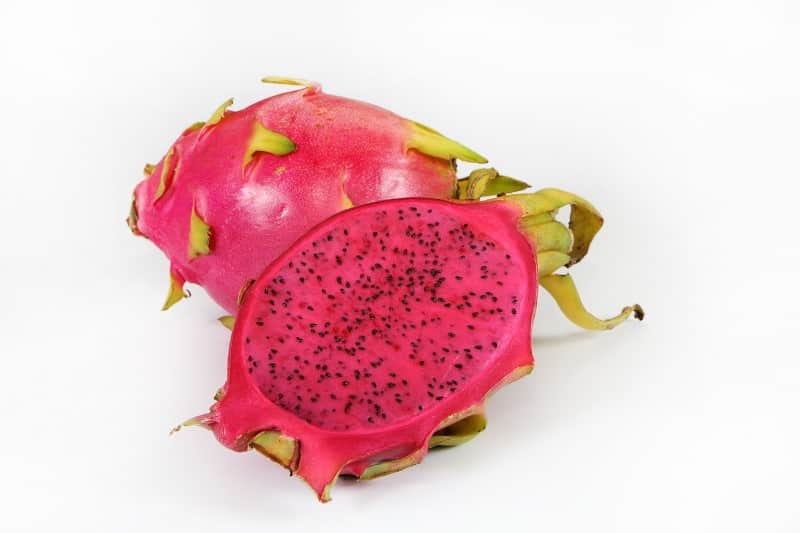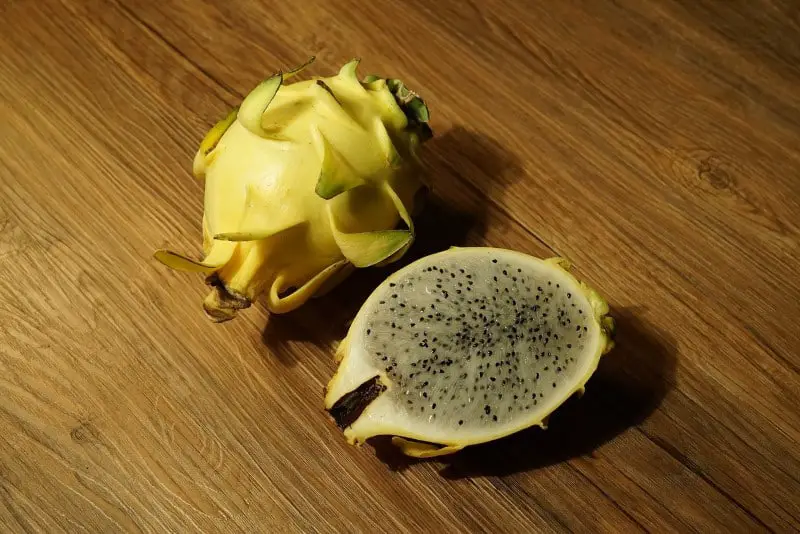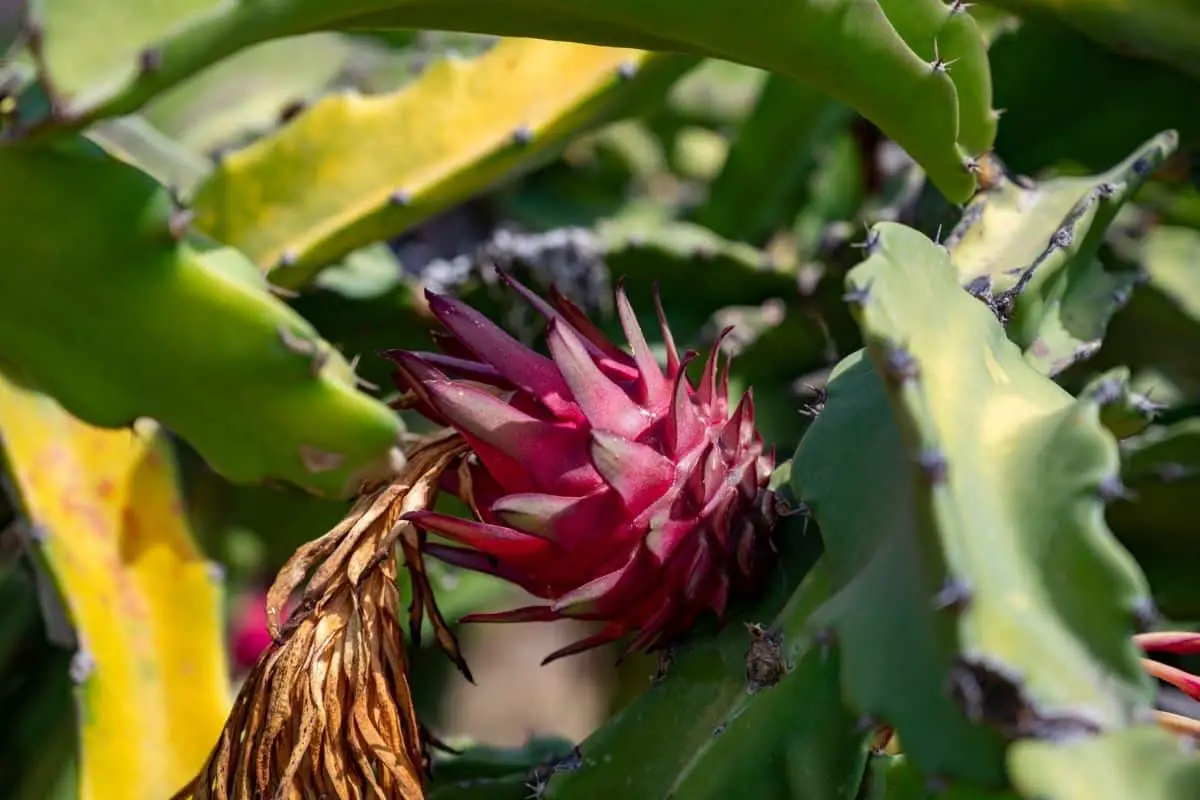There are five main species of dragon fruit plant that are commonly grown and each species has a number of different cultivars, varieties, and hybrids. Dragon fruits are the fruit of these different species of cacti and these plants grow as a vine with the fruit being produced on the ends of the long and often trailing, stems.
The original species of dragon fruit cacti originate from central and south America and grow in tropical and sub-tropical rainforests. For this reason, these cacti prefer a moister soil with plenty of organic matter added. They are fairly easy to grow in warmer climates but need to be protected from extreme cold and frost.
To grow dragon fruit cacti, you’ll need to give them some support such as a strong trellis. They can also be grown over a fence to give support to the aerial roots that the plant produces.
Let’s look at the differences between the species and the cultivars that are available for each species.
Hylocereus undatus (White fleshed pitaya)
This dragon fruit cactus produces fruits that have red or pink skin and snow-white flesh with tiny black, edible seeds. It’s probably the most commonly grown by home gardeners and commercial growers.
The fruit is completely spineless and has green bracts. The vine can get quite large and needs regular pruning to ensure that it produces side shoots. That’s because the fruit only grows on the current season’s stems. Before this, the plant produces magnificent large white flowers that are highly scented and only open at night.
There are numerous cultivars of this species and they include:
- Alice – Has very bright pink skin with long green bracts. It’s a semi-sweet fruit of medium size up to 1 pound. This variety needs to be cross-pollinated.
- David Bowie – This fruit is more slender than other varieties and has both a tangy and sweet flavor. Fruits are medium-sized up to 1 pound each. This one is self-pollinating.
- Guyute – This is a light pink fruit of medium size up to 1 pound. It’s a sweet fruit and is great eaten chilled. This is another self-pollinating variety.
- Harpua – This fruit has a snowy-white pulp and tastes somewhat like a melon. The fruit can reach a weight of around 1 pound each and it’s another self-pollinating cultivar.
- Lake Atitlan – The fruit of this cultivar has both a sweet and tart flavor and can reach a weight of around 1 pound. This is a self-pollinating variety.
- Neitzel – This is another self-pollinating variety with fruits up to 1 pound each. The flavor of this fruit is nice and sweet and it’s lovely eaten chilled.
- Seoul Kitchen – This is a lovely pale pink fruit weighing up to 1 pound each. The pulp is smooth and quite sweet. It’s a self-pollinating cultivar.
- Thompson – This produces quite a large-sized fruit up to 1.5 pounds. The pulp separates easily from the skin and is sweet and full of flavor. It’s a self-pollinator also.
- Vietnamese Jaina – This cultivar produces large red fruits that have a semi-sweet flavor and can each weigh around 1.5 pounds. It’s also self-pollinating.
Hylocereus costaricensis (Costa Rican pitaya)

This dragon fruit cactus also produces spectacular flowers that only open at night. The fruits on this plant have pink or red skins and red flesh with tiny black seeds. The texture of the pulp is quite similar to kiwi fruit. Be aware, that the pulp will stain your fingers.
You can grow this variety in a sunny spot but you should protect it from exposure to the very hot midday or afternoon sun. It has a shallow roots system so it’s important to water regularly so that the soil does not dry out completely. Make sure that the soil is well-draining too.
There is only one cultivar in this particular species.
- Costa Rican Sunset – The stems on this cactus vine do not have ribs but are, instead, elliptical in sections. It’s also a slow grower with fruit that is a rich cranberry color inside. The plant does need to be cross-pollinated with another variety.
Hylocereus polyrhizus (Red fleshed pitaya)
This is another species of red-fleshed dragon fruit with a small number of available cultivars. Its growth habit is similar to other species and it produces large fragrant flowers that have white petals and red or yellow bracts.
Here are the cultivars or hybrids with red flesh that are available:
- Bloody Mary – This variety is very similar to Red Jaina and needs to be cross-pollinated.
- Makisupa – This cultivar has pale pink skin and magenta-colored flesh. It has a sweet taste and is self-pollinating.
- Natural Mystic – The fruit on this cactus has pink skin and a dark red pulp with small black seeds. Each fruit can reach a weight of around 1 pound. It’s also a self-pollinating variety.
- Zamorano – Although this is a self-pollinating variety, you can get larger fruits if you do a little hand pollinating yourself. The fruits have a dark red flesh and are quite sweet.
- Red Jaina – This cactus is a heavy cropper and its species or origin is not known. The fruits can weigh up to 0.75 pounds each and have a dark red pulp. This is a particularly good variety for juicing. It does need to be cross-pollinated with another variety.
- Voodoo Child – This variety produces small fruits that are around the size of an egg. The flesh is quite sweet and has a flavor similar to grapes. This is a self-pollinating variety.
Hylocereus megalanthus (Yellow dragon fruit)

This species actually has bright yellow skin with the same green bracts as the white-fleshed varieties. The flesh inside is white with many small black seeds. It is commonly referred to as the tastiest dragon fruit on the market.
Be aware though, that the fruit has thorns that must be removed before use to avoid injuries to your fingers. The fruits are smaller in size and can reach a weight of around 0.75 pounds. It’s also a self-pollinating variety.
In late summer, the plant produces gorgeous trumpet-shaped flowers that are strongly scented. The fruits follow in around four to eight weeks. It can be grown in sun or semi-shade but should be protected from the hot afternoon sun. The plant also prefers rich, moist soil. It’s perfect for growing along a fence but make sure to protect it from extreme cold and frosts.
There are no cultivars or varieties of the yellow dragon fruit.
Hylocereus guatemalensis (American Beauty – Pink fleshed dragon fruit)
This separate species of dragon fruit commonly known as American Beauty has reddish-orange skin and bright pink flesh, again with small black seeds. It has a lovely flavor and is self-pollinated.
There are other cultivars that have pink flesh but these are usually hybrids mostly produced from crossing Hylocereus undatus with Hylocereus polyrhizus. Here’s a list of the other common pink-fleshed dragon fruit:
- Cosmic Charlie – (Hylocereus undatus X) – Produces large fruit up to 1.25 pounds and is self-pollinating.
- Dark Star – (Hylocereus undatus X) – Similar to Cosmic Charlie, with paler pink flesh with a mild grape-like flavor. This cultivar is also self-pollinating.
- Delight – (Hylocereus polyrhizus x undatus) – This has a pale pink flesh with a smooth texture. It’s also self-pollinating.
- Halley’s Comet – (Hylocereus undatus x polyrhizus) – This plant produces very large fruit that can weigh up to 2 pounds each. The skin is dusty red and the flesh is a lovely pink color.
- Physical Graffiti – (Hylocereus polyrhizus x H. undatus) – This is another hybrid variety that was bred by crossing a white-fleshed dragon fruit with a red-fleshed one. It produces large fruits up to 1.5 pounds in weight and is self-pollinating.
- Purple Haze – (Hylocereus undatus X) – This cultivar produces large fruits up to 2 pounds with bright pink flesh. It’s self-pollinating and the fruit has a slight kiwi flavor.
~ image source: depositphotos/foto-pixel.web.de
*References

